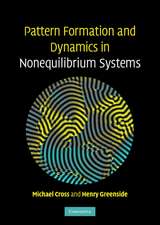Practical Bifurcation and Stability Analysis: Interdisciplinary Applied Mathematics, cartea 5
Autor Rüdiger U. Seydelen Limba Engleză Paperback – 3 mai 2012
| Toate formatele și edițiile | Preț | Express |
|---|---|---|
| Paperback (1) | 499.72 lei 6-8 săpt. | |
| Springer – 3 mai 2012 | 499.72 lei 6-8 săpt. | |
| Hardback (1) | 630.35 lei 3-5 săpt. | +35.37 lei 6-10 zile |
| Springer – 14 dec 2009 | 630.35 lei 3-5 săpt. | +35.37 lei 6-10 zile |
Din seria Interdisciplinary Applied Mathematics
- 15%
 Preț: 667.05 lei
Preț: 667.05 lei - 15%
 Preț: 487.25 lei
Preț: 487.25 lei - 20%
 Preț: 664.77 lei
Preț: 664.77 lei - 15%
 Preț: 980.97 lei
Preț: 980.97 lei - 17%
 Preț: 528.45 lei
Preț: 528.45 lei - 9%
 Preț: 630.35 lei
Preț: 630.35 lei - 18%
 Preț: 908.71 lei
Preț: 908.71 lei - 18%
 Preț: 1006.38 lei
Preț: 1006.38 lei - 15%
 Preț: 659.67 lei
Preț: 659.67 lei -
 Preț: 498.14 lei
Preț: 498.14 lei -
 Preț: 528.35 lei
Preț: 528.35 lei - 15%
 Preț: 659.02 lei
Preț: 659.02 lei - 15%
 Preț: 480.52 lei
Preț: 480.52 lei -
 Preț: 390.63 lei
Preț: 390.63 lei - 18%
 Preț: 918.61 lei
Preț: 918.61 lei -
 Preț: 388.52 lei
Preț: 388.52 lei - 15%
 Preț: 647.92 lei
Preț: 647.92 lei - 15%
 Preț: 655.60 lei
Preț: 655.60 lei - 23%
 Preț: 734.81 lei
Preț: 734.81 lei - 15%
 Preț: 660.83 lei
Preț: 660.83 lei - 18%
 Preț: 967.08 lei
Preț: 967.08 lei -
 Preț: 809.10 lei
Preț: 809.10 lei -
 Preț: 403.91 lei
Preț: 403.91 lei - 18%
 Preț: 896.84 lei
Preț: 896.84 lei - 18%
 Preț: 1004.00 lei
Preț: 1004.00 lei - 18%
 Preț: 974.19 lei
Preț: 974.19 lei -
 Preț: 399.67 lei
Preț: 399.67 lei - 23%
 Preț: 639.30 lei
Preț: 639.30 lei
Preț: 499.72 lei
Nou
Puncte Express: 750
Preț estimativ în valută:
95.63€ • 103.84$ • 80.33£
95.63€ • 103.84$ • 80.33£
Carte tipărită la comandă
Livrare economică 23 aprilie-07 mai
Preluare comenzi: 021 569.72.76
Specificații
ISBN-13: 9781461425304
ISBN-10: 1461425301
Pagini: 504
Ilustrații: XV, 477 p. 200 illus.
Dimensiuni: 155 x 235 x 26 mm
Greutate: 0.7 kg
Ediția:Softcover reprint of hardcover 3rd ed. 2010
Editura: Springer
Colecția Springer
Seria Interdisciplinary Applied Mathematics
Locul publicării:New York, NY, United States
ISBN-10: 1461425301
Pagini: 504
Ilustrații: XV, 477 p. 200 illus.
Dimensiuni: 155 x 235 x 26 mm
Greutate: 0.7 kg
Ediția:Softcover reprint of hardcover 3rd ed. 2010
Editura: Springer
Colecția Springer
Seria Interdisciplinary Applied Mathematics
Locul publicării:New York, NY, United States
Public țintă
ResearchCuprins
and Prerequisites.- Basic Nonlinear Phenomena.- Applications and Extensions.- Principles of Continuation.- Calculation of the Branching Behavior of Nonlinear Equations.- Calculating Branching Behavior of Boundary-Value Problems.- Stability of Periodic Solutions.- Qualitative Instruments.- Chaos.
Recenzii
From the reviews of the third edition:
"The outcome is impressive. The book is beautifully written in a style that seeks not only to develop the subject matter but also to expose the thought processes behind the mathematics." Proceedings of the Edinburgh Mathematical Society
“Methods of practical bifurcation and stability analysis are crucial instruments in applied mathematics. This fact stimulated the author to publish an up-to-date third edition, sixteen years after appearing the second edition. … The references contain more than 600 items. The excellent presentation of the material will stimulate people in applied sciences to apply the well-prepared instruments.” (Klaus R. Schneider, Zentralblatt MATH, Vol. 1195, 2010)
"The outcome is impressive. The book is beautifully written in a style that seeks not only to develop the subject matter but also to expose the thought processes behind the mathematics." Proceedings of the Edinburgh Mathematical Society
“Methods of practical bifurcation and stability analysis are crucial instruments in applied mathematics. This fact stimulated the author to publish an up-to-date third edition, sixteen years after appearing the second edition. … The references contain more than 600 items. The excellent presentation of the material will stimulate people in applied sciences to apply the well-prepared instruments.” (Klaus R. Schneider, Zentralblatt MATH, Vol. 1195, 2010)
Textul de pe ultima copertă
This book covers the central role that bifurcations play in nonlinear phenomena, explaining mechanisms of how stability is gained or lost. It emphasizes practical and computational methods for analyzing dynamical systems. A wide range of phenomena between equilibrium and chaos is explained and illustrated by examples from science and engineering. The book is a practical guide for performing parameter studies and includes exercises.
Combining an introduction on the textbook level with an exposition of computational methods, this book addresses the mathematical needs of scientists and engineers. It should be of interest to those in a wide variety of disciplines, including physics, mechanical engineering, electrical engineering, chemistry and chemical engineering, biology, and medicine. Both graduate students (in courses on dynamical systems, stability analysis, differential equations, and chaos) and professionals will be able to use the book equally well. The introduction avoids mathematical formalism, and the only required background is calculus.
In the third edition there is a chapter on applications and extensions of standard ODE approaches, for example, to delay equations, to differential-algebraic equations, and to reaction-diffusion problems. Additional material is inserted, including the topics deterministic risk, pattern formation, and control of chaos, and many further references.
Review of Earlier Edition:
"The outcome is impressive. The book is beautifully written in a style that seeks not only to develop the subject matter but also to expose the thought processes behind the mathematics." Proceedings of the Edinburgh Mathematical Society
Combining an introduction on the textbook level with an exposition of computational methods, this book addresses the mathematical needs of scientists and engineers. It should be of interest to those in a wide variety of disciplines, including physics, mechanical engineering, electrical engineering, chemistry and chemical engineering, biology, and medicine. Both graduate students (in courses on dynamical systems, stability analysis, differential equations, and chaos) and professionals will be able to use the book equally well. The introduction avoids mathematical formalism, and the only required background is calculus.
In the third edition there is a chapter on applications and extensions of standard ODE approaches, for example, to delay equations, to differential-algebraic equations, and to reaction-diffusion problems. Additional material is inserted, including the topics deterministic risk, pattern formation, and control of chaos, and many further references.
Review of Earlier Edition:
"The outcome is impressive. The book is beautifully written in a style that seeks not only to develop the subject matter but also to expose the thought processes behind the mathematics." Proceedings of the Edinburgh Mathematical Society
Caracteristici
Practical, hands-on approach Many examples and applications from science and engineering Numerical Approach Non-technical approach, only calculus required as background. Includes supplementary material: sn.pub/extras












